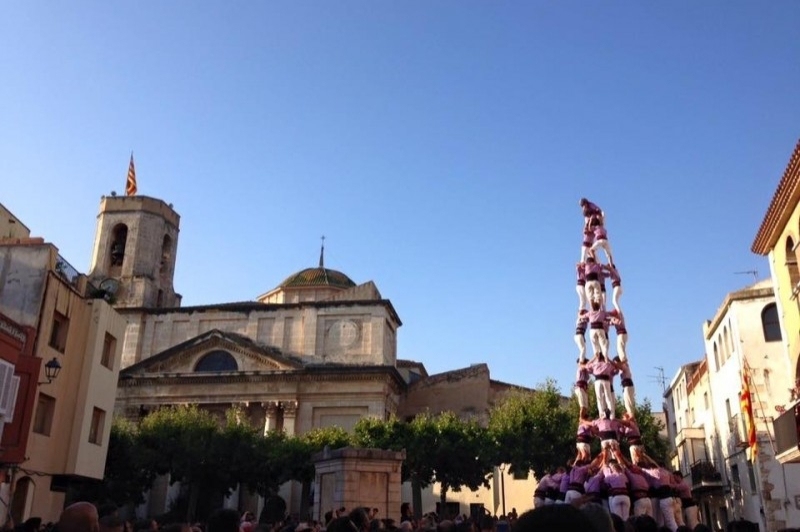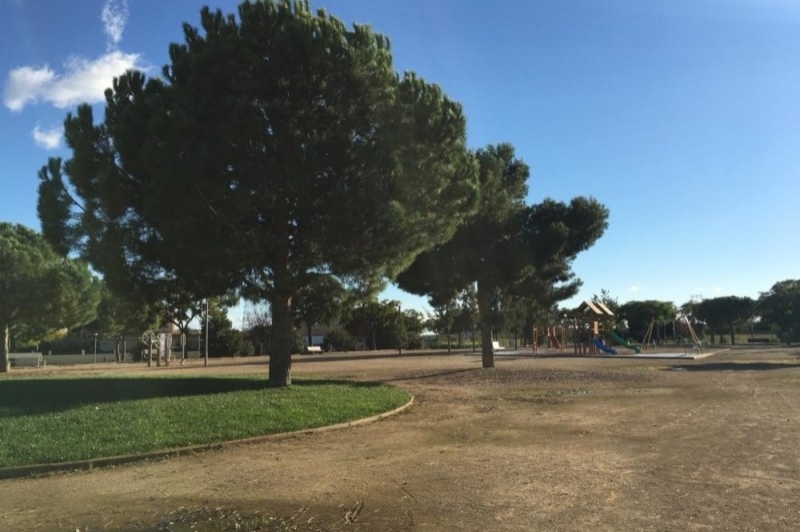Vilallonga del Camp
Vilallonga is a municipality in Tarragonès, located to the right of the Glorieta river, which constitutes its limit with the Rourell. The municipal area has an area of 9.23 km², and is crossed by the Vilallonga stream, a tributary of the Francolí river on the right. The town of Vilallonga, which is a clear example of a town-road, the only urban center, is located at 104 m. of altitude. It belongs to the judicial district in Valls and the archpriesthood of Valls. The municipality includes, in addition to the old town of Vilallonga, the historic towns of Carxol, Les Sorts and Mas de la Obra, the farmhouse and old stable of Montoliva and the old town of Font de l'Astor.
In the municipality of Vilallonga there are several Roman remains such as a building with a basilica plan and a rectangular tomb, which suggest consolidated settlements. No remains or documents have been preserved from the Saracen period.
The first population charter granted to the men of Villalonga by King Alfonso the Chaste dates from March 1, 1188. That first nucleus of Vilallonga must have been near the Granja de los Frailes and next to the royal road that went from Tarragona to Montblanc.
We know that Villallonga already existed before the granting of the population charter, because in the donation charter from Morell to Berenguer Desprats, 1173, it appears that it bordered Villallonga.
The War of Independence (1808-1811) had a considerable impact on Vilallonga del Camp. The city became the headquarters of the Spanish army for a few months and was then occupied by French troops in their advance towards the city of Tarragona.
Two important figures stand out in the municipality: Pere Virgili (1699 - 1776), considered the father of surgery in Spain for the founding of the Royal Colleges of Surgery of Cádiz and Barcelona, where he held the position of director of both colleges. He was chamber surgeon to King Ferdinand VI who granted him the privilege of nobleman in 1755. The other person to highlight is Josep Mestres y Miquel (1868-1945), doctor, politician and agronomist who founded the traveling professorship of agriculture. He was president of the Provincial Council of Tarragona, in addition to being part of the first Executive Council of the Commonwealth of Catalonia and was president of the Official College of Physicians of the province of Tarragona.
PLACES OF INTEREST
The most notable building in the town is the parish church of Sant Martí, construction began in 1795. It is worth highlighting the magnificent neoclassical façade, which was left unfinished. Above the cornice there is a triangular pediment supported by four columns and two pilasters, with Corinthian capitals. Above the entrance door you can see a relief that represents Saint Martin sharing the cloak with a poor man. Inside, the central nave and the lateral naves on both sides stand out. The transept is dominated by the dome. All painted with soft shades of green.
Within the district is the hermitage of the Virgen del Rosario, whose construction date is unknown. The building has undergone several transformations over the years, and is currently fully restored, having recovered the Gothic paintings of the presbytery and the craftsmanship. Its uniqueness is found in the mural paintings of the presbytery and the decoration of the beams.
The Dr. Pere Virgili Museum-Archive of Vilallonga del Camp is located in a building from the early 19th century that the Vilallonga del Camp City Council bought in 2000. Everything on the ground floor is related to the town of Vilallonga in the 18th century: its textile industry and the manufacture of brandy; the lost trades: cooper, saddler, miner and espadrille maker/shoemaker. In addition, there is a model of Vilallonga from the end of the 17th century, when Pere Virgili was born.
The first floor is dedicated to Dr. Pere Virgili. We must not forget that Pere Virgili was the one who created surgery in Spain. The title of the exhibition that can be seen on the first floor is "Pere Virgili and Spanish surgery of the 18th century, technical contributions". There are, among other things, several surgical instruments from the 18th century and some from the 19th century; as well as a replica of an 18th century ship's infirmary; the model of the Royal College of Surgery of Cádiz and different wax preparations of various parts of the body that were used to teach anatomy to surgery students.
Located at Sant Roc street, number 14 in Vilallonga del Camp, ca Nicolau is a house built at the end of the 17th century or beginning of the 18th century, which preserves the primitive structure and in which very few renovations have been made. In 2014, the Vilallonga del Camp City Council made an agreement with the owners of Ca Nicolau to be able to use it as a country house, aimed at preserving and displaying the material related to the town's peasantry that had been collected for years.
The Vilallonga del Camp Cinema Museum is the first cinema museum in Camp de Tarragona, it belongs to the City Council and is located in the Civic Center. The material found is the property of the collector Josep Maria Vallès, a resident of the municipality and a film fan.
All types of film material are exhibited in the museum, such as: projectors, film cassettes of different formats, graphic material, etc. There is a space for No-do and a space reserved for the three cinemas that the municipality has had.
Nearby routes
See all routes »- The route of the 4 villages of La Secuita (a 6.3 km)
- A trip to the universe of calçots (a 6.4 km)
- Cistercian Route: Culture, fauna and… (a 6.4 km)
- Route of Tarraco, The footprint of… (a 6.5 km)
- the castle fact (a 9.2 km)
What to do
Golf Costa Daurada
El Catllar (a 11.7 Km)Golf Costa Daurada is an 18-hole par 72 course that is perfectly…
Celler Vives Ambrós
Montferri (a 14.5 Km)Nestled in the heart of the Alt Camp wine region, in Montferri,…
Catedral de Tarragona
Tarragona (a 11.3 Km)The cultural visit of the site allows you to see in detail…
Where to eat
L'Orangerie de Clos Barenys
Vila-seca (a 16.2 Km)Under our fires, we prepare haute Mediterranean cuisine by selecting the finest…
Restaurant Denver Cambrils
Cambrils (a 19.9 Km)From the legendary Xiri to the current restaurant, Denver offers a creative…
Arena Tapas Restaurant
Salou (a 16.4 Km)Enjoy an innovative cuisine, with high-quality local products of proximity, with an…
Where to sleep
Port Plaza Apartaments
Tarragona (a 11.9 Km)Stay at the Port Plaza Apartments Tarragona, a place with a privileged…
Apartaments TGNA Cervantes 8
Tarragona (a 11.5 Km)The apartments at TGNA Cervantes 8 are designed to accommodate all types…
Apartaments TGNA Llúria 11
Tarragona (a 11.7 Km)TGNA Llúria 11 offers fully equipped apartments to ensure that our guests…
Apartaments TGNA Reding 22
Tarragona (a 11.4 Km)TGNA Reding 22 is an apartment building located in the heart of…
Events
Experiences
Visit with tasting to the Winery, Adernats - Nulles Winery
Adernats - Vinicola de Nulles (Nulles) (a 8.7 Km)


























